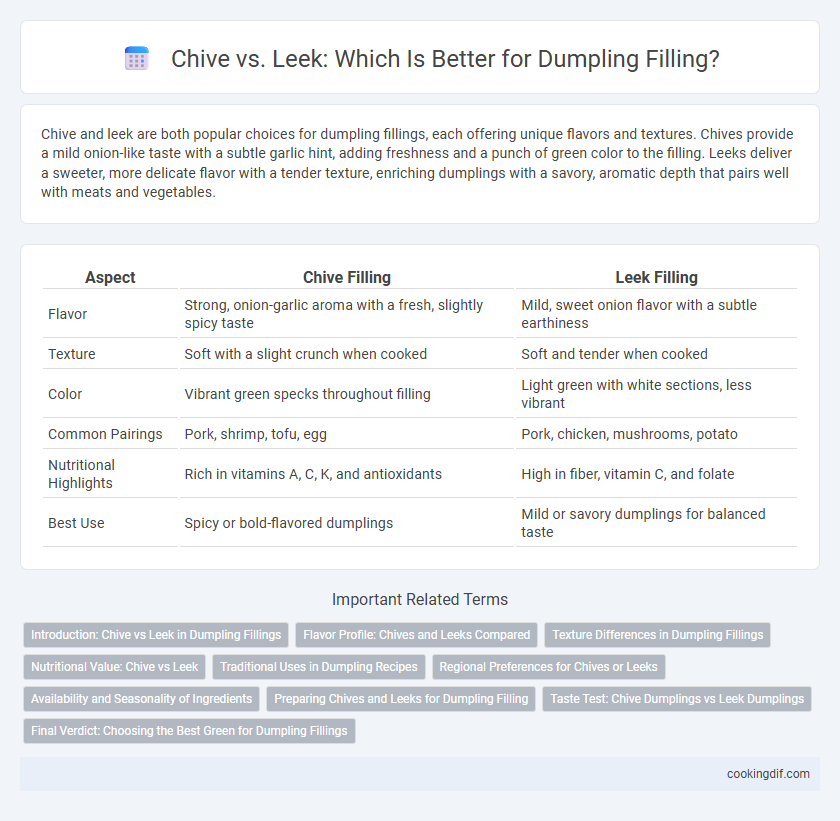Chive and leek are both popular choices for dumpling fillings, each offering unique flavors and textures. Chives provide a mild onion-like taste with a subtle garlic hint, adding freshness and a punch of green color to the filling. Leeks deliver a sweeter, more delicate flavor with a tender texture, enriching dumplings with a savory, aromatic depth that pairs well with meats and vegetables.
Table of Comparison
| Aspect | Chive Filling | Leek Filling |
|---|---|---|
| Flavor | Strong, onion-garlic aroma with a fresh, slightly spicy taste | Mild, sweet onion flavor with a subtle earthiness |
| Texture | Soft with a slight crunch when cooked | Soft and tender when cooked |
| Color | Vibrant green specks throughout filling | Light green with white sections, less vibrant |
| Common Pairings | Pork, shrimp, tofu, egg | Pork, chicken, mushrooms, potato |
| Nutritional Highlights | Rich in vitamins A, C, K, and antioxidants | High in fiber, vitamin C, and folate |
| Best Use | Spicy or bold-flavored dumplings | Mild or savory dumplings for balanced taste |
Introduction: Chive vs Leek in Dumpling Fillings
Chive and leek both enhance dumpling fillings with distinct flavors; chives offer a subtle onion-garlic aroma that brightens the filling, while leeks provide a milder, sweeter taste with a tender texture. Chives are commonly used in Asian-style dumplings for their pungent, fresh notes, whereas leeks add depth to European dumpling varieties with their slight earthiness. Selecting between chive and leek impacts the overall savory profile, influencing both aroma and texture in dumpling recipes.
Flavor Profile: Chives and Leeks Compared
Chives impart a mild onion flavor with subtle garlic undertones that complement delicate dumpling fillings, enhancing freshness without overwhelming other ingredients. Leeks offer a sweeter, more pronounced onion taste with a tender texture, adding depth and heartiness to the filling. Choosing between chives and leeks depends on the desired balance of lightness versus richness in the dumpling's flavor profile.
Texture Differences in Dumpling Fillings
Chive-filled dumplings offer a tender yet slightly crisp texture that contrasts with the softness of the dough, creating a balanced bite. Leek fillings tend to be meatier and more fibrous, providing a heartier texture that holds well during steaming or frying. Choosing between chives and leeks can significantly influence the mouthfeel, with chives delivering a light, fresh crunch while leeks add a robust, chewy dimension.
Nutritional Value: Chive vs Leek
Chives contain higher levels of vitamin K and vitamin C, contributing to bone health and immune support, while leeks offer more vitamin A and folate, essential for vision and cell function. Both vegetables are rich in antioxidants, but leeks provide a greater amount of dietary fiber, aiding digestion. Choosing between chive and leek for dumpling filling depends on specific nutritional needs, with chives boosting vitamin intake and leeks enhancing fiber consumption.
Traditional Uses in Dumpling Recipes
Chives are commonly used in traditional Chinese dumpling recipes, prized for their mild onion flavor and ability to balance pork or shrimp fillings. Leeks, often incorporated in Korean dumplings, add a sweeter, more robust taste and a slightly crunchy texture that complements beef or vegetable fillings. Both herbs enhance the dumpling experience by providing distinct aromatic qualities tailored to regional culinary preferences.
Regional Preferences for Chives or Leeks
Chive-filled dumplings dominate in East Asian cuisines, particularly in Chinese and Korean regional dishes, where the herb's sharp, garlicky flavor complements pork or shrimp fillings. Leek-stuffed dumplings are favored in European regions such as Eastern Europe, especially in Polish and Russian recipes, offering a milder, sweeter taste that pairs well with ground meat or mushroom mixtures. Regional preferences reflect the availability and traditional uses of chives and leeks, influencing the distinctive aroma and flavor profiles of dumpling fillings across cultures.
Availability and Seasonality of Ingredients
Chives are widely available year-round in most grocery stores, offering a mild onion-garlic flavor that complements dumpling fillings without overpowering other ingredients. Leeks have a more limited availability, primarily harvested in cooler months from late fall to early spring, making them a seasonal choice that imparts a sweeter, subtler taste to dumplings. Choosing between chive and leek depends on ingredient accessibility and desired seasonal flavor profiles for dumpling fillings.
Preparing Chives and Leeks for Dumpling Filling
Chives should be finely chopped and lightly sauteed to release their mild onion-garlic aroma without overpowering the dumpling filling. Leeks require thorough cleaning to remove grit, then thinly sliced and sauteed until tender to enhance their sweet, subtle flavor in the filling. Proper preparation of both chives and leeks ensures balanced taste and texture in dumplings, elevating the overall flavor profile.
Taste Test: Chive Dumplings vs Leek Dumplings
Chive dumplings offer a robust, garlicky flavor with a hint of onion, providing a bold and aromatic taste experience. Leek dumplings deliver a milder, sweeter profile with subtle earthy undertones, creating a delicate balance in the filling. Taste tests reveal that chive fillings appeal to those who prefer a punchier, more intense flavor, while leek fillings suit palettes seeking a smoother, less pungent bite.
Final Verdict: Choosing the Best Green for Dumpling Fillings
Chive and leek both offer distinct flavors and textures that enhance dumpling fillings, with chive providing a sharp, onion-garlic aroma and a tender bite, while leek contributes a milder, sweeter profile and a crunchier texture. Nutritionally, chives pack a higher vitamin K content, supporting bone health, whereas leeks offer more fiber and folate, beneficial for digestion and cell function. For the ideal dumpling filling, chives excel in bold, savory profiles, while leeks suit those preferring subtle sweetness and added texture, making the best choice dependent on the desired flavor complexity and nutritional benefits.
Chive vs Leek for filling Infographic

 cookingdif.com
cookingdif.com